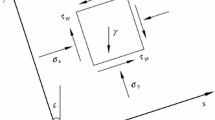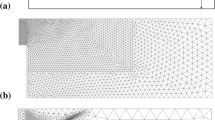The influence of the intermediate principal stress was considered based on the twin-shear unified strength theory. The calculation of the finite width earth pressure is treated as a plane strain problem. By using the static equilibrium method under the flat slip surface assumption, an analytical solution of the active earth pressure was obtained under the plane strain state, and the results were compared to the actual measurement results obtained by previous studies to verify the feasibility of the proposed method. The relevant parameters under different intermediate principal stress influence coefficients are discussed based on calculation examples. The earth pressure calculation, with consideration to the influence of the intermediate principal stress, has theoretical significance and considerable economic benefits in engineering.
Similar content being viewed by others
References
W. J. M. Rankine, “On the stability of loose earth,” Philos. Trans. Roy. Soc. London, 147, 9-27 (1857).
C. A. Coulomb, “Test on an application of the rules of maximums and minimums to some static problems related to architecture,” Mem. Math. Phys., 7, 343-382 (1776).
K. H. Paik and R. Salgado, “Estimation of active earth pressure against rigid retaining walls considering arching effects,” Géotechnique, 53, 643-653 (2003).
D. Wang and Y. Z. Wang, “Method for calculating active earth pressure of retaining wall based on energy theory,” Appl. Mech. Mater., 2545, 89-94 (2013).
C. J. Ouyang, Q. Xu, S. M. He, Y. Luo, and Y. Wu, “A generalized limit equilibrium method for the solution of active earth pressure on a retaining wall,” J. Mt. Sci-Engl., 10, 1018-1027 (2013).
M. X. Peng and J. Chen, “Slip-line solution to active earth pressure on retaining walls,” Géotechnique, 63, 1008-1019 (2013).
Y. Tang and J. G. Chen, “New approach for active earth pressure calculation on rigid retaining walls with cohesive backfill,” Soil Mech. Found. Eng., 57, 288-295 (2020).
S. Frydman and I. Keissar, “Earth pressure on retaining walls near rock faces,” J. Geotech. Geoenviron., 113, 586-599 (1987).
H. L. Wang, E. X. Song, and F. Y. Song, “Calculation of active earth pressure for limited soil between existing building and excavation,” Eng. Mech., 31, 76-81 (2014).
M. X. Xie, J. J. Zheng, R. J. Zhang, L. Cui, and C. X. Miao, “Active earth pressure on rigid retaining walls built near rock faces,” Int. J. Geomech., 20, 04020061 (2020).
B. S. Park, J. Lee, and S. D. Lee, “Experimental investigation of three-dimensional earth pressure according to aspect ratio of retaining wall,” Mar. Georesour. Geotechnol., 36, 181-189 (2018).
Z. W. Li, X. L. Yang, and Y. X. Li, “Active earth pressure coefficients based on a 3D rotational mechanism,” Comput. Geotech., 112, 342-349 (2019).
M. H. Yu, “Twin shear stress yield criterion,” Int. J. Mech. Sci., 25, 71-74 (1983).
M. H. Yu, L. N. He, and L. Y. Song, “Twin shear stress theory and its generalization,” Sci. China-Math., 28, 1174-1183 (1985).
M. H. Yu, Y. W. Zan, J. Zhao, and M. Yoshimine, “A unified strength criterion for rock material,” Int. J. Rock Mech. Min. Sci., 39, 975-989 (2002).
M. H. Yu, Unified Strength Theory and Its Applications, Springer, Berlin (2004).
J. P. Gao, Y. L. Liu, and M. H. Yu, “Unified strength theory with applications to earth pressure,” J. Xi’an Jiaotong Univ., 40, 357-364 (2006).
J. Ying, J. H. Liao, and W. C. Pu, “Earth pressure theory based on unified strength theory under plane strain state,” Chin. J. Rock Mech. Eng., 23, 4315-4318 (2004).
J. H. Zhao, W. B. Liang, C. G. Zhang, and Y. Li, “Unified solution of Coulomb’s active earth pressure for unsaturated soils,” Rock Soil Mech., 34, 609-614 (2013).
H. W. Ying, W. Zhu, D. Hong, X. Y. Xie, and B. H. Li, “Active earth pressures against rigid retaining walls with narrow cohesive backfill,” Chin. J. Geotech. Eng., 34, 13-18 (2012).
W. C. Gu, “Calculation of active earth pressure of cohesive soil,” J. Hydr. Eng., No. 1, 55-64 (1991).
W. A. Take and A. J. Valsangkar, “Earth pressures on unyielding retaining walls of narrow backfill width,” Can. Geotech. J., 38, 1220-1230 (2001).
Author information
Authors and Affiliations
Corresponding author
Additional information
Translated from Osnovaniya, Fundamenty i Mekhanika Gruntov, No. 3, May-June, 2023.
Rights and permissions
Springer Nature or its licensor (e.g. a society or other partner) holds exclusive rights to this article under a publishing agreement with the author(s) or other rightsholder(s); author self-archiving of the accepted manuscript version of this article is solely governed by the terms of such publishing agreement and applicable law.
About this article
Cite this article
Liu, H., Kong, D., Zhao, Y. et al. Active Earth Pressure of Finite Soil Based on Twin-Shear Unified Strength Theory. Soil Mech Found Eng 60, 259–267 (2023). https://doi.org/10.1007/s11204-023-09890-3
Published:
Issue Date:
DOI: https://doi.org/10.1007/s11204-023-09890-3




